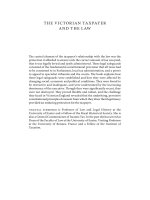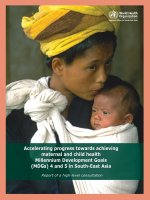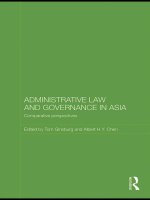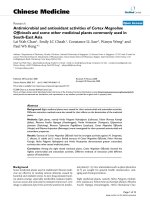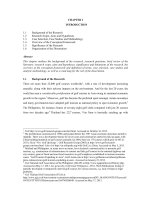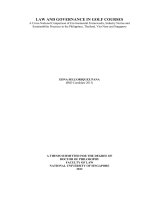NICE OR NASTY Food Choice, Food Law and Health in South East Asia doc
Bạn đang xem bản rút gọn của tài liệu. Xem và tải ngay bản đầy đủ của tài liệu tại đây (4.79 MB, 238 trang )
NICE OR NASTY
Food Choice, Food Law and
Health in South East Asia
i
prelims.pmd 12/9/02, 8:52 AM1
NICE OR NASTY
Food Choice, Food Law and
Health in South East Asia
John Candlish
University of Malaysia Sarawak
Chee-Hong Tan
National University of Singapore
iii
Australia • Canada • Mexico • Singapore • Spain • United Kingdom • United States
prelims.pmd 12/9/02, 8:52 AM3
Nice or Nasty: Food Choice, Food Law and Health in South East Asia
by John Candlish and Chee-Hong Tan
Copyright © 2003 by a division of Asia Pte
Ltd.
Learning is a trademark used herein under licence.
In respect of the rather charming period illustrations which originally appeared
in Peoples of All Nations, (Hammerton, N, Editor) Amalgamated Press, London,
published about 1920, the authors have strenuously attempted to trace any residual
owner of copyright, without success. They profoundly apologise if their efforts
were inadequate.
For more information, contact
Learning (a division of
Asia
Pte Ltd), 5 Shenton Way, #01-01 UIC Building, Singapore 068808. Or you
can
visit our Internet site at
ALL RIGHTS RESERVED
No part of this work covered by the copyright hereon may be reproduced or
used in any form or by any means graphic, electronic, or mechanical, including
photocopying, recording, taping, web distribution or information storage and
retrieval systems without the written permission of the publisher.
For permission to use material from this text or product, contact us by
Tel: (65) 6410 1200
Fax: (65) 6410 1208
Email:
6OFAIAJ >O Stallion Press
Printed in Singapore
1 2 3 4 5 SLP 05 04 03 02
ISBN 981-243-388-0
iv
Cengage Learning,
Cengage Learning
info@cengagelearning
Cengage
Cengage Cengage Learning
Acknowledgement
We are grateful to the China Medical Board of New York for a
grant in partial support of this work.
v
prelims.pmd 12/9/02, 8:52 AM5
This book is dedicated to
the nameless millions who toil over woks in
the streets of South East Asia,
providing nutritious meals for the poor.
vi
prelims.pmd 12/9/02, 8:52 AM6
vii
If you steal from one other its plagiarism.
If you steal from many its research.
Wilson Minzer
(18731933)
Food comes first, then morals.
Berthold Brecht
(18981947)
The public buys its opinions as it buys its meat, or takes
in its milk, on the principle that it is cheaper to do
this than keep a cow. So it is, but the milk is
more likely to be watered.
Samuel Butler
(18351902)
No one owns life, but anyone who can pick up
a frying pan owns death.
William Burroughs
(19141997)
prelims.pmd 12/9/02, 8:52 AM7
ix
Some Abbreviations Used
ADI Acceptable daily intake
AIA Advance informed agreement
ASEAN Association of South East Asian Nations
BINAS Biosafety Information Network and Advisory Service
CBD Convention on Biological Diversity
CAD Coronary artery disease
CITES Convention on International Trade in Endangered Species
DDT Dichlorophenyltrichloroethane
EED Environmental Endocrine Disrupter
EFA Essential fatty acid
EU European Union
FAO Food and Agricultural Organisation
FDA Food and Drug Administration
GMC Genetically modified crop
GMF Genetically modified food
GMO Genetically modified organism
GRAS Generally regarded as safe
HRT Hormone replacement therapy
JECFA Joint Expert Committee on Food Additives
LMO Living modified organism
MRL Minimum residue limit
NGO Non-government organisation
NOAEL No observed adverse effect level
OECD Organisation for Economic Cooperation and Development
PCB Polychlorinated biphenyls
PIC Prior informed consent
UNDO United Nations Development Organisation
UNEP United Nations Environmental Programme
WHO World Health Organisation
prelims.pmd 12/9/02, 8:52 AM9
Contents
Preface
1 Patterns of Food Avoidance and Selection 1
Some language Avoidance of specific foods
Selection of specific foods Some observations
2 Nice or Nasty 17
Unusual foods and the law Insect eating
Cats and dogs Rodents Scorpions Snakes
The Durian Milk Coconuts Alcohol
Cannibalism Some comparisons
3 Chinese Food Beliefs 43
The Chinese cuisine Hot and cold theories
Foods as medicines Language symbolism
The case of raw fish Aphrodisiac foods The
soya bean Birds nest - White rice Sharks
fin Alcohol Steamboat Food for the dead
The pace of change
4 Malay Food Beliefs 71
Kampung food Spices and condiments Hot and
cold theories Food and pregnancy Jamu Ulam
xi
xiii
prelims.pmd 12/9/02, 8:52 AM11
5 Food Advertising
Types of consumer Slimming advertisements
Specific slimming products Legal aspects Coda
6 Food and Medicine 103
Names and claims Interaction of health foods
with medical cultures The antioxidant
imbroglio Antidiabetic foods
Antihypertensives Sports foods The choice of
fats Some case studies Summing up
7 Toxins in Food 137
Invisible hazards Food safety legislation in South
East Asia Adulterants Additives Pesticides and
other contaminating residues Mycotoxins Heavy
metals Overfried and charred meats Environmen-
tal Endocrine Disrupters (EED) Micro-organisms
Naturally occurring toxicants Risk assessment
The toxic tort International law and food toxins
Round-up
8 Genetically Modified Foods in South East Asia 171
Emerging issues The problem of labels
Gleanings from the wider world
International efforts Risk assessment
9 Trends 195
Biological archetypes After affluence Natural
and organic food Street foods The concept of
healthy eating Scientific uncertainty and the
unease of the public Summing up
Index 215
xii Contents
xii
85
prelims.pmd 12/9/02, 8:52 AM12
Preface
At the beginning of a course of lectures on nutrition, we usually
challenge our students, as a diversion, to cite a disease, condition
or illness which does not have a nutritional component. They
usually ponder first on poor nutrition and meet the challenge by
citing, say, a broken leg in a car accident. This cannot at first sight
be due to lack of something in the diet. But of course a broken leg
needs calcium for its healing, and calcium must be supplied in the
diet if the bones are not to be weakened. Moreover, the driver of
the car may have been hypoglycaemic owing to anorexia or may
have been imbibing too much of that peculiar nutrient, alcohol. So
whereas faulty nutrition can cause disease, good nutrition is
important in treatment and management. There is some difficulty
in linking nutrition with psychoses and neuroses, but not much.
We read now that patients with schizophrenia may have insufficient
n3 fatty acids in their cells and that they can be put into remission
by feeding these in fish, nuts and beans. There is no problem in
fitting infectious diseases to the proposition, because it has been
known for many years that proper nutrition is needed for
immunocompetence, not to mention orderly convalescence from
their ravages. And in respect of infectious diseases, South East
Asia maintains a formidable prevalence, all the way from virus
xiii
prelims.pmd 12/9/02, 8:52 AM13
xiv Nice or Nasty
diseases like AIDS, through the bacterial forms such as tuberculosis,
to the plasmodium invasion of malaria.
Little concern over the connection between diet and
health is shown by governments, including the prototype world
government, the United Nations, through its agencies, the World
Health Organisation (WHO) and the Food and Agricultural
Organisation (FAO). Many societies are facing ageing populations
with an apparently infinite demand for healthcare. It was one of
the paradoxes of the 20th century that as disease, disability and
premature death were progressively overcome by medical science,
the resources which had to be spent on healthcare as a whole
increased exponentially. This is because one has to die of something,
and the period before death is associated with ever more expensive
medical technology; moreover, new and unsuspected hazards are
ever lurking round the corner. Thus diabetics can be helped to
survive by administering insulin, but at a fearful cost, later in life,
of kidney failure, amputations and blindness. Many cancers can
be cured if detected early, but the survivors cannot avoid
atherosclerosis, arthritis, osteoporosis and dementias, which are
the inevitable concomitants of long-term survival. The story of
the unexpected rise of HIV infection does not need retelling
here.
What then can be more attractive to governments facing the
heavy costs of medical subsidies than to prevent disease by
persuading their people to modulate their diets? Of course some
governments have been more active than others. In the United
States, the Center for Disease Control hands out frequent and
sensible advice. Ministries of Health in many countries make sure
that booklets explaining healthy eating are distributed to doctors
waiting rooms and public libraries. No government, as yet, actually
compels people to eat a specific diet, but sometimes it induces
choice by fiscal means. Thus the Malaysian government subsidises
11 foods at festival times, and milk powder permanently. In
November 2001 a shop in Kajang was fined 30,000 Malaysian
ringgit (US$8,000) for selling Dutch Lady milk (2.5 kg) at 39.30
Malaysian ringgit (US$10), as against the controlled price of
prelims.pmd 12/9/02, 8:52 AM14
Preface xv
33.30 Malaysian ringgit (US$9), in contravention of the Trade
Descriptions Act of 1972. This strikes one as quite severe.
As writers we need not apologise for treating South East Asia
as a unit, for few areas in the world have been so spectacularly
demarcated by nature.
1
The apparent extreme diversity of
language and culture gives way on closer examination to a
coherence of ancestral language, a topography of water and forest
and (importantly for this discusssion) a dominance of rice and
fish in the diet, with a very small role for meat and dairy products.
2
In the Association of South East Asian Nations (ASEAN) region as
a whole (to use the modern, geopolitical term), the officials most
concerned with food are from the Ministries of Agriculture,
sometimes also from those of Fisheries and Forestry. At a recent
meeting, in October 2001, they mentioned food many times in
their Press releases, but their language (as they would be the first
to admit) is merely exhortatory. Thus the Asian Vegetable Research
and Development Centre is required to address ASEANs need for
good quality/safe food and agricultural products. It was also agreed
to set up an ASEAN food security information system. In some
parts of ASEAN, efforts at nutritional education might still seem
a luxury. It was reported in 1998
3
that Indonesians were entering
Malaysia illegally in the hope of being arrested so that they could
enjoy proper meals in internment deportation camps, rather than
endless bowls of sweet potatoes and tapioca, which are of course
almost pure starch. The 25-km crossing from Sumatra to Johore
Bahru at the southern tip of Peninsular Malaysia is apparently
easily crossed, with a waiting list for transport; hence the new
concept of the prospective illegal immigrant. Whether the story is
true or not, it shows that the majority of the people of South East
Asia have the problem of getting enough food merely to keep going.
1
Reid A. South East Asia in the Age of Commerce, 14501680, vol 1. Yale University
Press, New Haven, 1988, p 1.
2
See accessed 20/11/01.
3
Straits Times, 6/3/89.
prelims.pmd 12/9/02, 8:52 AM15
xvi Nice or Nasty
4
By area, not population. Brunei is the smallest country in ASEAN by population.
A new entrant to the nations of the area, East Timor, is also not large in either
population or area.
5
Straits Times, 11/3/97.
6
They were not unthinkable in the past. During the Vietnam war the Thais sent a
contingent to fight with the US troops; in the early sixties Indonesia took up arms
against Malaysia.
In contrast, in Singapore, the smallest country,
4
the
government has realised that oversufficiency is the main dietary
problem, and it organises a symbolic, annual work-out on the
Padang (the sports field) in front of the Supreme Court. Also in
Singapore, the Ministry of Health in 1997 embarked on a full
analysis of 800 locally cooked dishes and analysed them for 22
nutrients. Considering that each nutrient was analysed several
times to acquire average values, one needs only simple arithmetic
to appreciate the magnitude of this task. Initial results
5
showed
that fibre, vitamin A and iron intakes were below recommenda-
tions, whereas sodium and cholesterol intakes were higher. This
led to headshaking by the newspapers over the supposed excess
consumption of salt and animal fat.
If there are few Ministers of Food in the ASEAN region, there
is a full complement of Ministers of Foreign Affairs, who at a
meeting in August 2001 made a declaration, widely reported in
the Press, that a war between any of the member-states was now
unthinkable.
6
This is a reminder that the best endeavours of a
government to improve the health of its citizens, by dietary or
other means, can be destroyed by war. That was vividly brought
home by the near-emaciated appearance of the Vietnamese we
saw on film and television during the conflict there. One would
hope that wars fought for reasons of national pride are at an end,
but the threatened attack on Taiwan by the Peoples Republic of
China gives pause thereon. It has often been suggested, on the
other hand, that future wars will be fought over water. However,
ASEAN, with the exception of Singapore, does not seem to be
short of water. According to an editorial in the Lancet:
prelims.pmd 12/9/02, 8:52 AM16
Preface xvii
some disasters build slowly and quietly and such is
the drought currently plaguing Iran, South China, the Middle
East, North and Sub-Saharan Africa, South Korea and central
America. The United Nations estimates some 25 million water
refugees
7
South East Asia is notably absent from this long list. Water is the
mainstay of agriculture, and agriculture means food. To the
objection that some wars, for example the Gulf War of 1990, were
fought over oil, it must be stated that oil is only the means by
which food is produced, processed and transported. The West, as
often, has shown the wrong way. The assassination of Archduke
Ferdinand in Sarajevo in 1914 was not the cause of the First World
War; it was about hegemony on the continent, which meant
expansion of territory, which meant food. The Second World War
was merely an extension of the First and was even more predicated
on food the desire of Germany for wheat from the Ukraine and
of the Japanese for rice from Burma and Indonesia. If such disasters
can now be averted and if some modest prosperity can be clawed
from an economic upturn subsequent to the current slump, then
we may see genuine food choice operating all over Asia, with the
delightful increase in the quality of life which that entrains.
7
Editorial, Lancet 358 (2001) 1025. In South East Asia, the control of major water
resources, like the Mekong, seems to continue to be settled amicably. There is,
however, something of a dispute over the supply of water to Singapore by Malaysia.
prelims.pmd 12/9/02, 8:52 AM17
Some language
The necessity for human beings to take in food at regular intervals
seems so mundane and obvious that its patterns and paradigms,
until recently, have been peripheral to sociology, a discipline which,
at least in its scientific sense, slightly predates nutrition science. It
seems that social anthropologists have taken more heed of food
1
and have even managed to link the origin of monogamy to it.
Thus, it is thought that the early human fathers may have provided
food for their mates to ensure fidelity; that is, while away from the
cave on hunting expeditions they could be sure that, in exchange
for food, their mates would exclude the possibility of impregnation
by other males, thus ensuring the propagation of their own
genes.
2
In modern times Levi-Strauss is often quoted as writing:
Food must not only be good to eat, but also good to think. As
a structural sociologist (indeed the founder of the school) he
Patterns of Food Avoidance
and Selection
1
1
1
Murcott A. World Review of Nutrition and Dietetics 55 (1988) 1.
2
It has to be noted that at present this theory is somewhat in the shade. See Hagmann
M. Science 283 (1999) 777.
2 Nice or Nasty
maintained that myths cannot be understood in isolation, but only
as parts of an extended system. In other words, the connections of
and transformations between myths (the structure) are what is
important, not the myths themselves. Since Levi-Strausss seminal
book on the subject is called The Raw and the Cooked,
3
the analogies
to the overall pattern of food consumption, as opposed to the
choice of specific foods, become obvious. The other great authority
on the social significance of food in the last century, Douglas, is
said to be equally structuralist in that we can understand culinary
tradition as only a part of the total cultural experience of an
individual.
4
We write as nutritionists, not sociologists or anthropologists.
Nutrition science and its empirical foundation, biochemistry, have
from the beginning been concerned not with human behaviour
but with human health. They have been very successful in working
out the types and quantities of nutrients that the body needs for
maintaining growth and well-being.
5
It is still thrilling to read the
story of the discovery of vitamin B
1
in Jakarta, when the Dutch
physician Eijkman realised that there was something in rice chaff
which prevented his pet chickens from contracting a type of
neuropathy. So now, we are advised to choose brown rather than
white bread when we go to the supermarket or the bakery. If we
prefer (process being comparable) to buy white bread, that may
not be in our best interests, but is in accord with the observation
of anthropologists that even in the most deprived communities
and tribes some sort of food choice operates, if only on festival
occasions. Choice means challenge; as Sclafani puts it: Food
selection represents a major challenge for omnivorous species.
Faced with a variety of foodstuffs, many beneficial and some
3
Levi-Strauss C. The Raw and the Cooked. Jonathan Cape, London, 1970.
4
Douglas M. Purity and Danger: An Analysis of Concepts of Purity and Taboo.
Routledge and Keegan Paul, London, 1966.
5
But not completely successful. It has proved impossible, for example, to determine
exactly the amounts of protein needed in the diets of either individuals or groups.
Food Avoidance and Selection 3
deleterious, the omnivore must decide which to eat and which to
reject.
6
In this work we wish to explore the patterns of food choice in
South East Asia, and we feel it necessary, initially, to investigate
whether there is any language to describe the categories of choice.
We are aware that this matrix has been addressed by eminent
anthropologists,
7
but their approach is integrative to society as a
whole. We dare not go that far. It may also be necessary to adopt
some neologisms. Coinage of words is a pleasant pastime for
pedants wishing to show off their roots (usually Greek), but can
be tiresome for their readers, if they are fortunate enough to gain
any. Nonetheless, there do not seem to be any existing descriptives
which succinctly define some of the concepts to be explored in
this small book. However, some terms relating to what one may
loosely describe as the psychology of food choice do indeed pre-
exist. The term lipophobia has been adopted by Fischler
8
it refers
to the excessive abhorrence of fats in connection with obesity,
heart disease and cancer. (He could have been more concise and
called it spratism, after Jack Sprat.) Fruitarian has been introduced
or at least used by Walker
9
for those advocating massive
consumption of fruit in the interests of health (largely in the
interests of acquiring vitamin C, supposedly to ward off cancer,
and potassium to reduce hypertension). The word carboholic,
meaning a person excessively fond of starchy foods, and which
hints at present or future obesity, has been in currency for some
time. Neophobism (fear of new things) and neophilism (love of new
things) have been used in connection with food, but obviously do
not refer specifically to it.
6
Sclafani A. Proceedings of the Nutrition Society 54 (1994) 417.
7
See note 1, p 1.
8
Fischler C. In: Dietary Fats: Determinants of Preference, Selection and Consumption
(Mela D J, Ed). Elsevier, London, 1992, p 192.
9
Walker A R P. Nutrition Reviews 53 (1995) 1995.
4 Nice or Nasty
Avoidance of specific foods
In connection with avoiding foods, the first term which comes to
mind is taboo originally Polynesian, and according to the Oxford
English Dictionary imported into English (and possibly many other
languages) by none other than Captain James Cook after he noted
its use in Tonga. It readily entered into common currency, implying
that there was a socio-linguistic need for it although it has roughly
the same meaning as superstition, this latter term has a more weak-
minded connotation. Taboo is a useful word to fall back on, but is
too wide to be useful in every situation of food avoidance. One
can perhaps delineate six reasons for eschewing specific foods.
(We are not here concerned with the avoidance of all food. Those
who avoid food in general, like prisoners on hunger strike and
anorexics, also have made a choice, but not a choice specific to
certain foods.) Avoidance attitudes, then, can perhaps be classified
as:
1. Foods thought to be dirty, dangerous or obnoxious on
grounds which can be substantiated by science, observation
or common sense. A recent example would be the avoidance
of beef thought to be associated with bovine spongiform
encephalopathy or its human sequel, JacobCreutzfeldt
disease. Alcoholic beverages are sensibly avoided by those
who exhibit the alcohol-flushing syndrome (Chapter 3) and
milk by those suffering from lactose intolerance (Chap-
ter 2). An ancient example would be the avoidance of beans
by followers of the ancient Greek philosopher Pythagoras,
who evidently had some empirical knowledge of the
haemolytic condition now called favism, caused by defects
in the gene for the enzyme glucose 6-phosphate de-
hydrogenase. A reasonable term to describe this mode of
choice would be acacophagia from the Greek roots caco- (bad,
poor, sick) and phagia (eat). A specialised aspect is of course
vegetarianism, where the practitioner abstains from meat
products for health reasons, as opposed to religious
conviction.
Food Avoidance and Selection 5
Here we must include the avoidance of animal products
vegetarianism in other words. Many would regard this
as a rational choice in the interests of health insofar as it
minimises saturated fat intake, includes a sufficient variety
of plant foods, and contains much fibre and a good
complement of vitamins and minerals. The avoidance of
foods which are not natural or organic, a very modern
phenomenon, will also have to be noted here (and is
mentioned again in Chapter 9).
2. Foods associated with the nature of ones condition. Here
the food is not in itself obnoxious, or at fault; rather it is
temporarily to be avoided because of some special
circumstance. Such avoidances are often associated with
pregnancy and lactation. Eschewing alcoholic beverages in
those states would be an example. In the East, while doing
their stint as Buddhist monks, men avoid heaty foods.
Into this category too we have to put medical prohibitions,
such as the limitations on dietary protein in those with
kidney disease. This category seems to elide into the one
above, but the crucial distinction is that, in this context,
there is nothing wrong with the food; if anything, it is the
abstainer who is deficient. It is difficult to ascribe a single
name to this category, because so many different strands
contribute to it. A variant, or an extension of it, though, is
the avoidance of foods handled by others in a condition
thought unsatisfactory; thus in some societies men will not
eat food prepared by menstruating women.
3. Foods avoided because of class distinctions. It is said that
some Indians of high castes will not eat food prepared by
lower castes. Otherwise, there may well be foods chosen
by or reserved for the elite and avoided by the lower classes
for that reason, or conversely (more commonly) foods
eschewed by the elite because of prominent consumption
by the commonality. Thus Whitehead points out that food
carries complex cultural meanings: think of muesli and
beef burgers, smoked salmon and prawn cocktail, chocolate
6 Nice or Nasty
eclairs and steamed jam pudding.
10
The implication is that
jam pudding tastes very nice, by all accounts, but is avoided
by those with some discrimination. The concept was
explored in some depth 100 years ago by Veblen, who
coined the term conspicuous consumption. In The Theory
of the Leisure Class, he points out that in a primitive
(he calls it a predatory) culture, the only economic
differentiation is between a superior class made up of able-
bodied men and an inferior class of labouring women. The
consumption of choice articles of food, and frequently also
of articles of adornment, becomes tabu to the women
and children; if there is a servile class of men, it becomes
tabu to them also. Under the tabu certain victuals, and
more particularly certain beverages, are strictly reserved
for the use of the superior class. To quote him: Since the
consumption of these more excellent goods is an evidence
of wealth, it becomes honorific; and conversely, the failure
to consume in due quantity and quality becomes a mark of
inferiority and demerit.
11
To jump 100 years from Veblen,
there may well still be servile beings who do not drink
champagne because they believe it is reserved for the upper
classes (but they must be few). There may well be aristocrats
who will touch neither fish and chips nor a Big Mac, not
on the grounds of palatability, but rather by dint of disdain
for the non-discriminating classes. But we venture to assert
that such phenomena are all but unknown in South East
Asia. One can discern this in respect of street food. In this
part of the world everybody eats in the street (meaning
street stalls, rather than pavement cafes fronting bistros).
All classes will flock to the scruffiest stall if its reputation
is good. This category of avoidance may be described as
Veblenism, because he pioneered its description.
10
Whitehead A. In: Food (Harriss-White B and Hoffenberg R, Eds). Blackwell,
Oxford, 1994, p 116.
11
Veblen T. The Theory of the Leisure Class. Allen and Unwin, London, 1959.
Food Avoidance and Selection 7
4. Foods associated with unpleasant people, like enemies. One
may argue again that this elides into item 3 above, if ones
antagonists in the class war are considered unpleasant. One
could consider (in a less Marxist frame) that if skinheads,
who like to go to the seaside and cause rumpuses, were
known to be fond of specific foods (lager beer, perhaps),
such foods would find little favour with seaside
landladies.
12
At the time of writing this (October 2001) it
seems probable that if it becomes known that Osama bin
Laden is preternaturally fond of pitta bread, we are sure
that sales of pitta bread will decline all over the world. The
20th century was full of unpleasant in fact, abominable
heads of state, and perhaps fortunately for sections of the
food industry, few of their dietary preferences became
public. We did know a historian, an expert on the Third
Reich, who would never touch vegetarian spaghetti because
that was Hitlers last meal in the Berlin bunker before he
shot himself. It is quite possible that if when visiting
Penang, say, you are beaten up, robbed, minimally helped
by the police, and let down by the medical services, you
will never touch Penang laksa again.
The English thought that the French existed largely on
frogs and snails, and these never found a place on tables
in England when that nation was the traditional enemy. In
South East Asia there are admittedly few parallels.
Memories of the Japanese occupation are still strong, there
is much discontent about the lack of veracity in Japanese
history books, but Japanese food is very popular.
5. Foods derived from pleasant animals, such as pets. Many
young ladies will not eat rabbit. Most Europeans and Asians
will never eat dogs or cats. People of most countries do not
like to eat horses, and the reason for this has caused some
12
Groups of youths (skinheads) gravitate towards the seaside resorts in
summertime Europe and cause disruption by their rowdy behaviour.
8 Nice or Nasty
speculation among historians and anthropologists.
Apparently, the earliest domesticated horses were used for
meat they were not at that stage strong enough in the
back to bear a human being. Some say that in Europe at
any rate the eschewing of horsemeat derives from an
injunction of Pope Gregory III in 732, who was seeking to
put an end to a pagan practice. Others believe that the
benefits in agriculture, warfare and transport conferred by
the horse, as long as it did not eat too much grain,
outweighed its potential food value. Then again there may
just be respect for the horse, rather similar to that of the
Hindu for the cow. We do not believe there is any equivalent
abhorrence of eating pleasant or familiar plants. The
diffidence about eating pets can be called acyonophagia from
the Greek cyono-, dog.
6. Foods derived from unpleasant animals (or plants), so
rendered because of cultural tradition or straight religious
prohibition. This refers to the well-known prohibition of
pork in the Jewish and Muslim faiths, of alcohol in the
latter, and of beef in the Hindu system, and these are so
well known as to need no elaboration. Coffee and tea are
not taken by Mormons. Seventh Day Adventists do not eat
animal foods. In one of the major religions of Asia (and
now elsewhere), Buddhism, there is a reluctance to eat all
animal foods, especially beef. Superficially, no neologisms
are needed for these. If the avoidance is part of your own
religion it is called a prohibition; if it is embodied in the
religion of somebody else you call it a taboo. It is suspected
by anthropologists that many of these avoidances are more
comprehensible if one accepts the view that religious beliefs
here in the context of food have little to do with
spirituality but a lot to do with the social cohesiveness of
particular groups. It has to be said, also, that the division
between pleasant and unpleasant animals may be at
base elusive, because at least in unsophisticated societies
there is a tendency to overestimate the mental processes of
Food Avoidance and Selection 9
animals. Thus the Kenyahs of Borneo, if about to go fishing,
speak of the matter as little as possible lest the birds should
overhear their conversations and inform the fish of their
purpose, so that the latter can swim away downstream.
That is why many groups will not kill and eat any creature
so malignant looking and potentially harmful as a snake.
So forbidden food animals are more respected than detested.
The probiscus monkey looks too human (and therefore too
intelligent) to be eaten by some Bornean tribes.
Clearly, there is an interaction with the first category
above if the religious prohibitions are derived, or
supposedly derived, to protect co-religionists from the
dangers of unwholesome food. But pork, according to
Harris,
13
is banned in the Jewish and Muslim faiths not
because it is unwholesome, but because the pig was an
unsuitable animal for the Middle East, in that it needs shade
and water to keep cool and food other than grass. It may
be that beef is unwelcome to Buddhists not because it is
unwholesome as such, but because it is heaty and so
inflames the senses.
Selection of specific foods
Again, this enquiry looks at particular foods, or food categories,
rather than active gluttony/gourmandising (known scientifically
as hyperphagia) as such. Whether or not, as mentioned above,
sociologists have taken much interest in food choice, there is no
debate about the interest of those whose business is marketing,
which may be loosely defined as the means of making people buy
things they do not particularly want. Drew summarises the process
as being, first of all, a perception, by the consumer, which forms
part of an attitude, leading to a behavioural intention, culminating in
13
Harris M. Good to Eat. Simon and Schuster, New York, 1985, p 84.
10 Nice or Nasty
what can be directly observed, namely a behaviour. The first of
these is said to be fuelled by both myth and information.
14
We do
not propose an analysis of this complexity; suffice it to claim that
there are at least six modes of choice, and most of them are based
on myth rather than on information.
1. Eating the flesh of the slain enemy to gain his characteri-
stics, strength, prowess or fame. This is not like
conventional cannibalism (if there is such a thing, see
Chapter 2), undertaken in an emergency merely to stay
alive. Like the others below, it operates when there is
otherwise food in plenty. In modern times Idi Amin,
the former boss of Uganda, was said to practise this
habit. This could be called dynophagia, from the Greek
dyno-, or power.
A report in the Straits Times during the Indonesian
troubles in 1999 had it that in the Sambas district of
Kalimantan, gangs of Malays and Dayaks were hunting
down Madurese and in one grisly scene, the body of
one man was burned at the market place in Sambas and
small shredded bits of liver of the victim were offered to
the public in the local tradition of eating parts of ones
enemy.
15
Another variant, also from Indonesia, is exhibited by the
marathon runner Ruwiyati, who drinks some blood from
her coachs finger before the start of every race. The report
16
did not state how the blood is obtained, but this appears
to be a version of what psychiatrists call vampirism, and it
is said that such rituals are involved in battle and
initiation ceremonies as well as dietary and fertility mores.
17
14
Drew K. In: Understanding Natural Flavours (Piggot J R and Paterson A, Eds).
Blackie Academic and Professional, London, 1994, p 165.
15
Straits Times, 11/7/99.
16
Straits Times, 31/10/97.
17
Fahy T, Wessley S and David A. Medicine, Science and the Law 28 (1988) 145.
